What Does a Phlebotomist Do?
If you want to get into a high-demand role in the medical field, consider becoming a certified phlebotomist. What is a phlebotomist? The word phlebotomy comes from the Greek words for “vein” and “cutting.” In ancient history, phlebotomists were trained in bloodletting, a practice that believed removing blood from the body of a sick person would lead to healing. That practice has long since been abandoned, but the word phlebotomist has stuck.
Today, a phlebotomist is a healthcare professional that specializes in collecting samples from patients, primarily through blood draws. This role is crucial for blood testing, where samples are most often obtained from veins, although capillary blood, such as that from a finger prick, is also collected for smaller tests. The collected blood may serve various purposes, including contributing to a patient’s healthcare plan, being used for donations, or supporting research projects. Beyond blood, phlebotomists are also trained to collect other types of specimens when necessary, including sputum, urine, stool, and hair samples. However, their main responsibility remains focused on phlebotomy, the practice of drawing blood.
Phlebotomists are primarily stationed in laboratories and medical centers, where they are responsible for collecting blood and other specimens, such as urine, for lab testing. This role is critical in assisting physicians to arrive at precise diagnoses for their patients. It demands meticulous attention to detail and a steady hand to perform effectively. Financially, the profession offers a range of compensation; as reported by the Bureau of Labor Statistics, salaries for phlebotomy professionals vary from $30,000 to $51,000 annually. Furthermore, the field is experiencing a robust job growth rate of 8%, which is notably above the average, highlighting the increasing demand for skilled phlebotomists in the healthcare sector.
Typical Duties of a Phlebotomist
The primary role of a phlebotomist is to draw blood from medical patients. They also draw blood from blood donors. In this role, they will take time to help the patient feel relaxed, and they will assist with any anxiety the patient feels about blood draws. However, that is just a part of what the phlebotomist does. They will also:
- Verify the identity of the patients
- Properly label all blood and other fluids collected
- Ensure sterile containers are used to collect blood and urine
- Provide patient instruction for self-delivered samples, such as urine.
- Enter information into a database to ensure the lab handles the materials well
- Use and dispose of medical equipment correctly, including proper handling of needles
- Keep a sanitary lab or work area
- Apply bandages to the area after taking blood
- Taking vital signs for a patient
- Educating patients about procedures
- Interact with patients and ensure a high level of patient satisfaction
To be good at their jobs, phlebotomists should know about blood types and the way medications and diet can impact blood samples. They should understand how to prepare patients for procedures,
Where Do Phlebotomists Work?
According to the Bureau of Labor Statistics, the majority of phlebotomists work in hospitals or in medical and diagnostic laboratories. However, they are also employed in physician’s offices, outpatient care centers, and other healthcare services facilities. Blood donation banks and plasma donation centers, for instance, utilize the help of phlebotomists to draw donations from patients. Long-term care centers will have pantomimists come in from time to time to take samples from their residents to avoid the need to travel to the healthcare center. Traveling phlebotomists can even go to people’s homes to collect samples to send to the lab.
No matter where the phlebotomist works, they will likely spend a lot of time on their feet. This is a fast-paced job, and there are roles that cover all times of day, especially when employed in a hospital setting.
What Skills Are Necessary for Phlebotomists?
To be a phlebotomist, you should have good people skills, especially when dealing with individuals who are scared or nervous. Your skills will help them calm down so they can get their procedures done.
In addition, you need to be comfortable around blood and bodily fluids. This is the daily work of a phlebotomist, so you will have to have a high level of comfort in this area.
Phlebotomists need to have steady hands so they can easily draw blood without causing a significant amount of bruising for patients. Strong communication skills are also important, because phlebotomists will communicate with both patients as well as the lab and doctors ordering tests.
Organization is essential in this field. You must be able to accurately label and store samples, and sometimes phlebotomists have to deal with the insurance paperwork necessary to get paid.
Getting Started on the Path to Becoming a Phlebotomist
If you are interested in becoming a phlebotomy technician, the first step is to go to phlebotomy school. Advanced eClincial Training has convenient online training that will get you started. You can attend phlebotomy school with a schedule that works for you. We also weave clinical experience into our online certification programs so you can get the hands-on training you need while in our program. Enroll now to start your training and advance your career as a phlebotomist.


